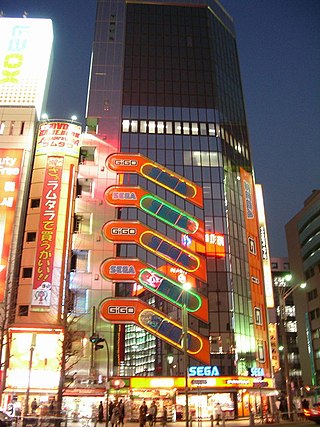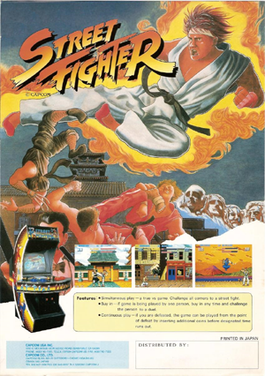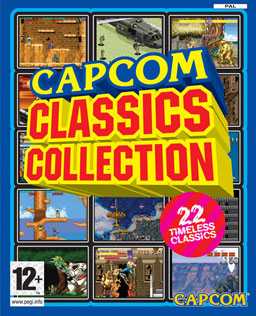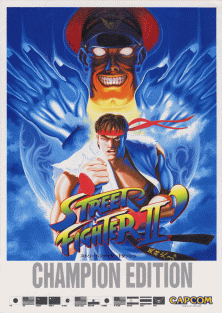
Capcom Co., Ltd. is a Japanese video game company. It has created a number of critically acclaimed and multi-million-selling game franchises, with its most commercially successful being Resident Evil, Monster Hunter, Street Fighter, Mega Man, Devil May Cry, Dead Rising, Dragon's Dogma, Ace Attorney, and Marvel vs. Capcom. Established in 1979, it has become an international enterprise with subsidiaries in East Asia, Europe, and North America.

An amusement arcade, also known as a video arcade, amusements, arcade, or penny arcade, is a venue where people play arcade games, including arcade video games, pinball machines, electro-mechanical games, redemption games, merchandisers, or coin-operated billiards or air hockey tables. In some countries, some types of arcades are also legally permitted to provide gambling machines such as slot machines or pachinko machines. Games are usually housed in cabinets.

Street Fighter II: The World Warrior is a 2D fighting game developed by Capcom and originally released for arcades in 1991. It is the second installment in the Street Fighter series and the sequel to 1987's Street Fighter. It is Capcom's fourteenth game to use the CP System arcade system board. Street Fighter II vastly improved many of the concepts introduced in the first game, including the use of special command-based moves, a combo system, a six-button configuration, and a wider selection of playable characters, each with a unique fighting style.

Ikari Warriors, known as Ikari in Japan, is a vertically scrolling run and gun video game released for arcades by SNK in 1986. It was published in North America by Tradewest. At the time there were many Commando clones on the market. What distinguished Ikari Warriors were rotary joysticks and a two-player cooperative mode. The rotary joystick controls were in turn based on SNK's earlier TNK III (1985). Ikari was originally intended to be an official licensed adaptation of the film Rambo: First Blood Part II (1985), but SNK were initially unable to acquire the rights to the film.
Redemption games are typically arcade games of skill that reward the player proportionally to their score in the game. The reward most often comes in the form of tickets, with more tickets being awarded for higher scores. These tickets can then be redeemed at a central location for prizes. The most inexpensive prizes may require only a small number of tickets to acquire, while the most expensive ones may require several thousand. In general, the amount of money spent to win enough tickets for a given prize will exceed the value of the prize itself. Some redemption games, such as Flamin' Finger, involve elements of chance, which can be set by the operator.

Kung-Fu Master, known as Spartan X in Japan, is a side-scrolling beat 'em up developed by Irem as an arcade video game in 1984, and distributed by Data East in North America. Designed by Takashi Nishiyama, the game was based on Hong Kong martial arts films. It is a loose adaptation of the Jackie Chan, Sammo Hung, and Yuen Biao film Wheels on Meals (1984), called Spartan X in Japan, with the protagonist Thomas named after Jackie Chan's character in the film. The game is also heavily inspired by the Bruce Lee film Game of Death (1972), which was the basis for the game's concept. Nishiyama, who had previously designed the side-scrolling shooter Moon Patrol (1982), combined fighting elements with a shoot 'em up gameplay rhythm. Irem and Data East exported the game to the West without the Spartan X license.

Ghosts 'n Goblins, known as Makaimura in Japan, is a platform video game developed by Capcom and released for arcades in 1985. It is the first game in the Ghosts 'n Goblins franchise, and has since been ported to numerous home platforms.

Commando, released as Senjō no Ōkami in Japan, is a vertically scrolling run and gun video game released by Capcom for arcades in 1985. The game was designed by Tokuro Fujiwara. It was distributed in North America by Data East, and in Europe by several companies including Capcom, Deith Leisure and Sega, S.A. SONIC. Versions were released for various home computers and video game consoles. It is unrelated to the 1985 film of the same name, which was released six months after the game.
The following article is a broad timeline of arcade video games.
Yoshiki Okamoto, sometimes credited as Kihaji Okamoto, is a Japanese video game designer. He is credited with producing popular titles for Konami, including Gyruss and Time Pilot, and for Capcom, including 1942, Gun.Smoke, Final Fight and Street Fighter II. He later founded the companies Flagship and Game Republic, and then created the hit mobile games Dragon Hunter and Monster Strike for Mixi. He also played a role in the creation of Rockstar's Red Dead franchise. Several franchises he helped create are among the highest-grossing video game franchises of all time, including Street Fighter,Monster Strike and Red Dead.
1988 saw many sequels and prequels in video games, such as Dragon Quest III, Super Contra, Super Mario Bros. 2, Mega Man 2, Double Dragon II: The Revenge, and Super Mario Bros. 3, along with new titles such as Assault, Altered Beast, Capcom Bowling, Ninja Gaiden, RoboCop, Winning Run and Chase H.Q.

Trojan is a side-scrolling action game developed by Capcom, originally released as a coin-operated arcade video game in 1986, and published in North America by Romstar and Capcom. Directed by Takashi Nishiyama, the game includes beat 'em up and hack-and-slash elements. It is a spiritual successor to the beat 'em up Kung-Fu Master (1984), which was designed by Nishiyama at Irem before he left for Capcom, where he evolved its gameplay concepts with Trojan. It is also considered a spiritual successor to Capcom's Ghosts 'n Goblins (1985), which has similar side-scrolling action gameplay elements.
Romstar Inc. was a video game distribution company based in Torrance, California that started operations in 1984. They originally started as the first American distribution arm for SNK. They were known for licensing arcade games from major makers for distribution. Among Romstar's clients include Taito, Capcom, SNK, Toaplan, and Seta. They also made games for the Nintendo Entertainment System, the Super Nintendo Entertainment System, and Game Boy. The ultimate fate of the company is not known. Games continued to be released using the Romstar name until at least 1994. It is also partnered with Capcom in 1993 to form Game Star, an electromechanical factory in Arlington Heights, Illinois that Romstar had a 30% stake in. In 1995, Capcom would later fully take over Game Star to form Capcom Coin-Op, a pinball manufacturer.

Street Fighter is a 1987 arcade fighting game developed and published by Capcom. It is the first competitive fighting game produced by the company and the first installment in the Street Fighter series. It was a commercial success in arcades and introduced special attacks and some of the conventions made standard in later fighting games, such as the six-button controls and the use of command-based special moves.

Capcom Classics Collection is a compilation of arcade games released by Capcom for the PlayStation 2 and Xbox on September 27, 2005 in North America and in 2006 in Japan. It was developed by Digital Eclipse Software, Sensory Sweep, and its Japanese developer Klein Computer Entertainment. A second volume, Capcom Classics Collection Vol. 2, was released on November 24, 2006 in North America, for PlayStation 2 and Xbox. The second volume as well as the Xbox version of the first volume were not released in Japan.

Black Tiger, known in Japan as Black Dragon, is a hack-and-slash platform game released for arcades by Capcom in 1987.

T.A.N.K. is a 1985 vertically scrolling multidirectional shooter developed and released in arcades by SNK. It was published in North America as TNK III by Kitcorp. Versions of T.A.N.K. for home computers were released by Ocean Software for the ZX Spectrum, Commodore 64, and Amstrad CPC in 1987. A sequel was also released for the Nintendo Entertainment System titled Iron Tank.

Street Fighter II: Champion Edition, released as Street Fighter II Dash in Japan, is a fighting game released by Capcom in 1992. It was launched for arcades and converted to several video game consoles. It is the first of several updated versions of Street Fighter II, and part of the Street Fighter series. The main changes are the addition of the four grand masters as playable characters and mirror matches. The fighting techniques of the eight main characters from the original game were further balanced for competitive play.

Capcom Arcade Stadium is an arcade video game compilation by Capcom. It includes 32 arcade games originally published by Capcom between 1984 and 2001. The compilation was initially released on Nintendo Switch in February 2021, then on PlayStation 4, Windows, and Xbox One in May 2021, and Amazon Luna in May 2022.

An arcade game or coin-op game is a coin-operated entertainment machine typically installed in public businesses such as restaurants, bars and amusement arcades. Most arcade games are presented as primarily games of skill and include arcade video games, pinball machines, electro-mechanical games, redemption games or merchandisers.















